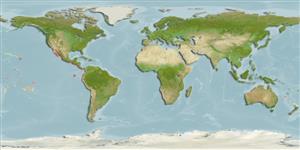>
Beloniformes (Needle fishes) >
Hemiramphidae (Halfbeaks)
Etymology: Hyporhamphus: Greek, hypo = under + Greek, rhamphos = beak, bill (Ref. 45335); naos: Named for the Naos Island, Bay of Panama, where the species is common and the site ot the Smithsonian Tropical Research Institute (STRI) Marine Laboratory..
Environment: milieu / climate zone / depth range / distribution range
Ecologia
marinhas; estuarina; intervalo de profundidade 0 - ? m. Tropical
Eastern Pacific: from Baja California, with strays north to San Diego, CA, south to Paita, Peru and in the Galapagos Islands.
Tamanho / Peso / Idade
Maturity: Lm ? range ? - ? cm
Max length : 29.0 cm SL macho/indeterminado; (Ref. 96012); peso máx. publicado: 74.50 g (Ref. 96012)
Descrição suscinta
Chaves de identificação | Morfologia | Morfometria
Raios dorsais (total) : 12 - 16. This species is distinguished by the following characters: dorsal and anal fin bases of adults are covered with scales; first gill arch rakers total 29-39, second gill arch rakers total 21-28; pelvic to caudal extension falls anterior to opercle and posterior to upper jaw; for continental population, pelvic to caudal distance usually 0.44-0.47 to SL; preorbital length to orbital diameter usually greater than 0.70 (in 81% of 119 specimens examined) (Ref. 42105).
Inhabits inshore, coastal and estuarine; found along sand beaches, in lower tidal streams and mangroves. Usually encountered in schools at the surface of the water (ref. 42105).
Ciclo de vida ou comportamento de acasalamento
Maturities | Reprodução | Spawnings | Egg(s) | Fecundities | Larvas
Banford, H.M. and B.B. Collette, 2001. A new species of halfbeak, Hyporhamphus naos (Beloniformes: Hemiramphidae), from the tropical eastern Pacific. Rev. Biol. Trop. 49(1):39-49. (Ref. 42105)
Status na Lista Vermelha da UICN (Ref. 130435)
Ameaça para os humanos
Harmless
Uso pelos humanos
Ferramentas
Relatórios especiais
Baixar XML
Fontes da internet
Estimates based on models
Índice de diversidade filogenética (Ref.
82804): PD
50 = 0.5000 [Uniqueness, from 0.5 = low to 2.0 = high].
Bayesian length-weight: a=0.00245 (0.00134 - 0.00449), b=3.11 (2.96 - 3.26), in cm total length, based on LWR estimates for this species & Genus-body shape (Ref.
93245).
Nível Trófico (Ref.
69278): 3.0 ±0.4 se; based on size and trophs of closest relatives
Resiliência (Ref.
120179): Elevada, tempo mínimo de duplicação da população menor que 15 meses (Preliminary K or Fecundity.).
Fishing Vulnerability (Ref.
59153): Low to moderate vulnerability (25 of 100).
